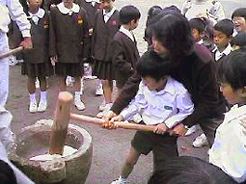ANNUAL CALENDAR December |
|
Mochi-tsuki
|
 Mochi-tsuki, or pounding rice to make mochi (rice cakes), is an important traditional event in preparation for the New Year. It's usually performed at the end of the year, from around December 25 to 28.
Mochi-tsuki, or pounding rice to make mochi (rice cakes), is an important traditional event in preparation for the New Year. It's usually performed at the end of the year, from around December 25 to 28.
Making mochi is simple. A special type of sticky rice that's been soaked in water overnight and steamed is placed in an usu, a large bowl made of wood or stone. A heavy, hammer-like kine is used to pound the rice into paste. The kine is heavy, so when a family makes mochi together, the father usually does the pounding, with the mother regularly shifting the rice in the usu (with hands moistened to prevent the mochi from sticking) to ensure evenness. The mother then shapes the pounded rice into small portions with the help of the children. After the mochi are completed, some are set aside as divine offerings. The decorative kagami mochi--two flat, round mochi placed one on top of the other, with the lower mochi being slightly larger--represents the seat of the New Year deities. Even at room temperature, mochi will keep for a fairly long time. People start eating the homemade mochi with the dawning of the new year. They're usually cooked over a flame and flavored with soy sauce or are placed in a soup called zoni. The Japanese have traditionally believed that all material objects are imbued with spirits, and so by partaking of mochi--thought to symbolize the spirit of rice--they hoped themselves to gain the strength of these rice divinities. Modernization has seriously weakened the mochi-tsuki tradition, however. Although some farming households still pound their own mochi, most urban residents usually order mochi from specialty shops or buy machine-made, plastic-wrapped rice cakes from the supermarket.
Photo: Many schools have annual mochi-tsuki events; here, children await their turn while a classmate takes a turn with the kine. (Tsurumaru Elementary School) |
APR | MAY | JUN | JUL | AUG | SEP | OCT | NOV | DEC | JAN | FEB | MAR |
 |